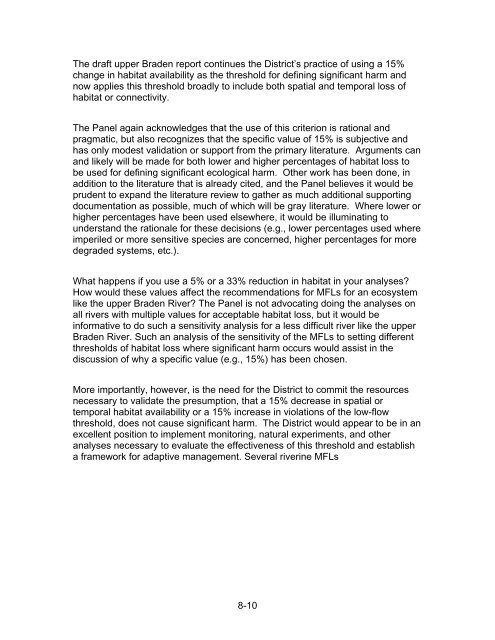Chapter 1 Minimum Flows and Levels - Southwest Florida Water ...
Chapter 1 Minimum Flows and Levels - Southwest Florida Water ...
Chapter 1 Minimum Flows and Levels - Southwest Florida Water ...
You also want an ePaper? Increase the reach of your titles
YUMPU automatically turns print PDFs into web optimized ePapers that Google loves.
The draft upper Braden report continues the District’s practice of using a 15%<br />
change in habitat availability as the threshold for defining significant harm <strong>and</strong><br />
now applies this threshold broadly to include both spatial <strong>and</strong> temporal loss of<br />
habitat or connectivity.<br />
The Panel again acknowledges that the use of this criterion is rational <strong>and</strong><br />
pragmatic, but also recognizes that the specific value of 15% is subjective <strong>and</strong><br />
has only modest validation or support from the primary literature. Arguments can<br />
<strong>and</strong> likely will be made for both lower <strong>and</strong> higher percentages of habitat loss to<br />
be used for defining significant ecological harm. Other work has been done, in<br />
addition to the literature that is already cited, <strong>and</strong> the Panel believes it would be<br />
prudent to exp<strong>and</strong> the literature review to gather as much additional supporting<br />
documentation as possible, much of which will be gray literature. Where lower or<br />
higher percentages have been used elsewhere, it would be illuminating to<br />
underst<strong>and</strong> the rationale for these decisions (e.g., lower percentages used where<br />
imperiled or more sensitive species are concerned, higher percentages for more<br />
degraded systems, etc.).<br />
What happens if you use a 5% or a 33% reduction in habitat in your analyses?<br />
How would these values affect the recommendations for MFLs for an ecosystem<br />
like the upper Braden River? The Panel is not advocating doing the analyses on<br />
all rivers with multiple values for acceptable habitat loss, but it would be<br />
informative to do such a sensitivity analysis for a less difficult river like the upper<br />
Braden River. Such an analysis of the sensitivity of the MFLs to setting different<br />
thresholds of habitat loss where significant harm occurs would assist in the<br />
discussion of why a specific value (e.g., 15%) has been chosen.<br />
More importantly, however, is the need for the District to commit the resources<br />
necessary to validate the presumption, that a 15% decrease in spatial or<br />
temporal habitat availability or a 15% increase in violations of the low-flow<br />
threshold, does not cause significant harm. The District would appear to be in an<br />
excellent position to implement monitoring, natural experiments, <strong>and</strong> other<br />
analyses necessary to evaluate the effectiveness of this threshold <strong>and</strong> establish<br />
a framework for adaptive management. Several riverine MFLs<br />
8-10
















